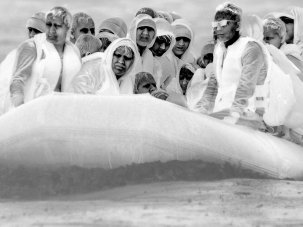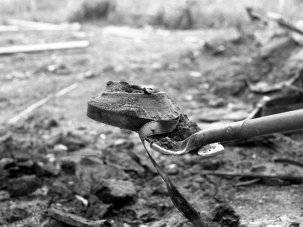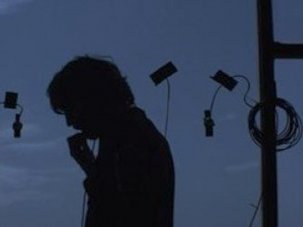What makes an artist ‘political’? Inspiring images, biting satire, defiant protest – or none of these? In the case of Willie Doherty, it’s more often a matter of us imagining what lies behind tranquil images; what happened in the past. In his Ghost Story (2007), sumptuously photographed by Seamus McGarvey and voiced by Stephen Rea, we were propelled along a tree-lined path toward the site of a brutal sectarian execution, recalled in fragments, somewhere near Doherty’s native Derry. Its companion piece, Buried, silently picked over abandoned clothing, wire coils and a burnt-out fire, the banal debris that mark this grisly site of memory.
Loose Ends is at Matt’s Gallery, London SE1 until 30 July.
Doherty grew up during Northern Ireland’s Troubles and even witnessed Derry’s Bloody Sunday massacre as a teenager. But if his art seems to be haunted by this history, his method is scrupulously detached. He has spoken of wanting to ‘slow down’ what is often presented as action, and to reveal or discover what’s usually hidden. Seeing his first major retrospective in Derry, Unseen, during the city’s 2013 City of Culture festival was a disturbing, unforgettable experience. Alongside Ghost Story and Buried, the very banality of a yard behind shops that was the scene of a ‘knee-capping’ punishment, or the tranquillity of a country road where a suspected informer was executed, seemed chilling in Doherty’s large photographs – offering no closure or reassurance.

His new two-screen diptych, Loose Ends, seems at first sight more serene. Created to mark the centenary of the 1916 Easter Rising, it reaches Matt’s Gallery in London as the final venue in a tour that started in Letterkenny, Co. Donegal, then went to the Kerlin Gallery in Dublin.
The trajectory is significant, for Doherty now lives in Donegal, and his response to the anniversary call was to reflect on how the Rising related to this distant corner of Ireland. What the Irish Volunteers were fighting for, he concluded, was a vision of Ireland that had its roots in the rural West. This led him to one of the little-known strands of the Easter Rising story: how a yacht crewed by two fishermen from the remote Donegal island of Gola had sailed to Dublin in 1914, bringing a cargo of ancient rifles bought in Germany for future use by republicans.
Some of these outdated Mausers were in fact used during the battle around the General Post Office two years later. But when British bombardment set the Post Office on fire, Patrick Pearse and his surviving comrades broke out into nearby Moore Street – which was ironically called ‘Ireland’s Alamo’ during efforts to prevent it being demolished for redevelopment in early 2016.

The images of Loose Ends could hardly be more remote from any familiar iconography of the Easter Rising, matched by the meditative commentary voiced by Séan McGinley. Gola’s miniature landscape is archetypal rural Ireland, framed by a rough stone window opening. And its rocky Atlantic coast might seem merely picturesque, although the yacht Asgard faced heavy storms on its mission. Moore Street today is a derelict city terrace, boarded up and host to a variety of weeds and decay. Anti-heroic, or a wry view of the futility of memorialisation? The text muses on time, decay and the inevitable fictionalisation of the past.
Although I doubt very much that Doherty intends to comment on the legacy of Easter 1916 and its memorialisation by the Irish state. By being photographically literal and almost forensic, he is, paradoxically, broadening the issues at stake. How do we relate any historic events to the places in which they unfolded, especially when they’re not famous sites? I’m reminded that my father, who was living in Derry as a child during 1916, recalled how sympathetic skirmishing in the city during Easter had confined him to his house while bullets flew along the street – an even more forgotten episode than those that Doherty documents.

It has to be said that Loose Ends presents a ravishing palette of textures and surfaces, all poignantly yet also sensuously imprinted with the passage of time. Having recently seen Bill Morrison’s latest ode to decaying nitrate film, Dawson City, Frozen Time, it is hard not to reflect on how digital video has a special ability to immerse us in an aesthetic reverie, which seems to feed avidly on the spectacle of decay.
In an interview for his work’s premiere, Doherty talked about the decision on this occasion not to track but to zoom, as a way of engaging with the process of ageing – a way of thinking about time rather than space, he suggests. Yeats’s Easter, 1916 gave us one of the great meditations on how revolution can change our perception of time’s transformation – how from the merely mundane “a terrible beauty is born”. Doherty’s Loose Ends offers a typically oblique and modest, yet for me powerful, meditation on that beauty, elsewhere and a century later.
-
The Digital Edition and Archive quick link
Log in here to your digital edition and archive subscription, take a look at the packages on offer and buy a subscription.









